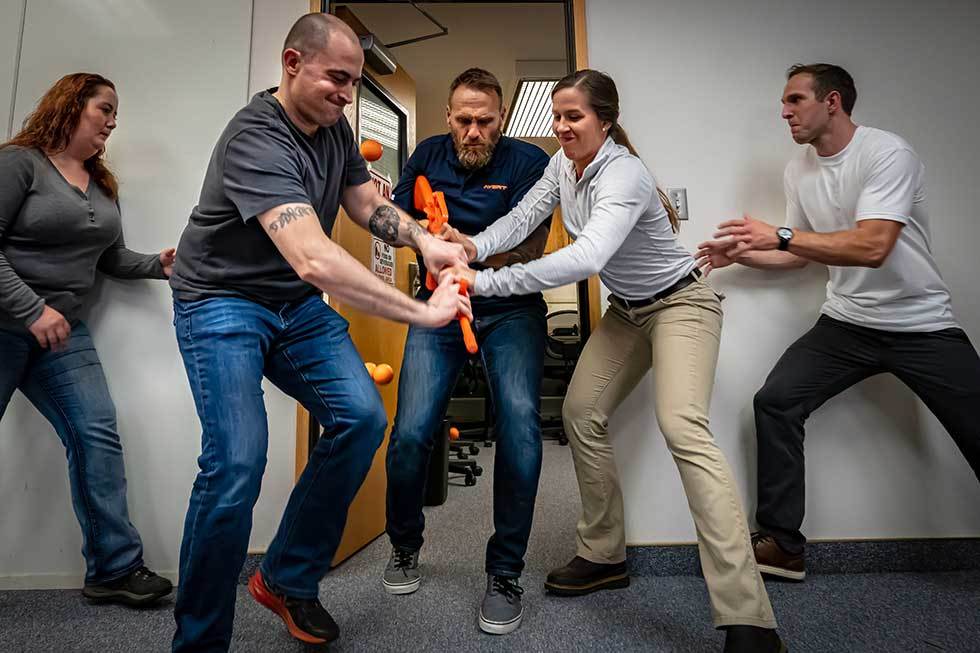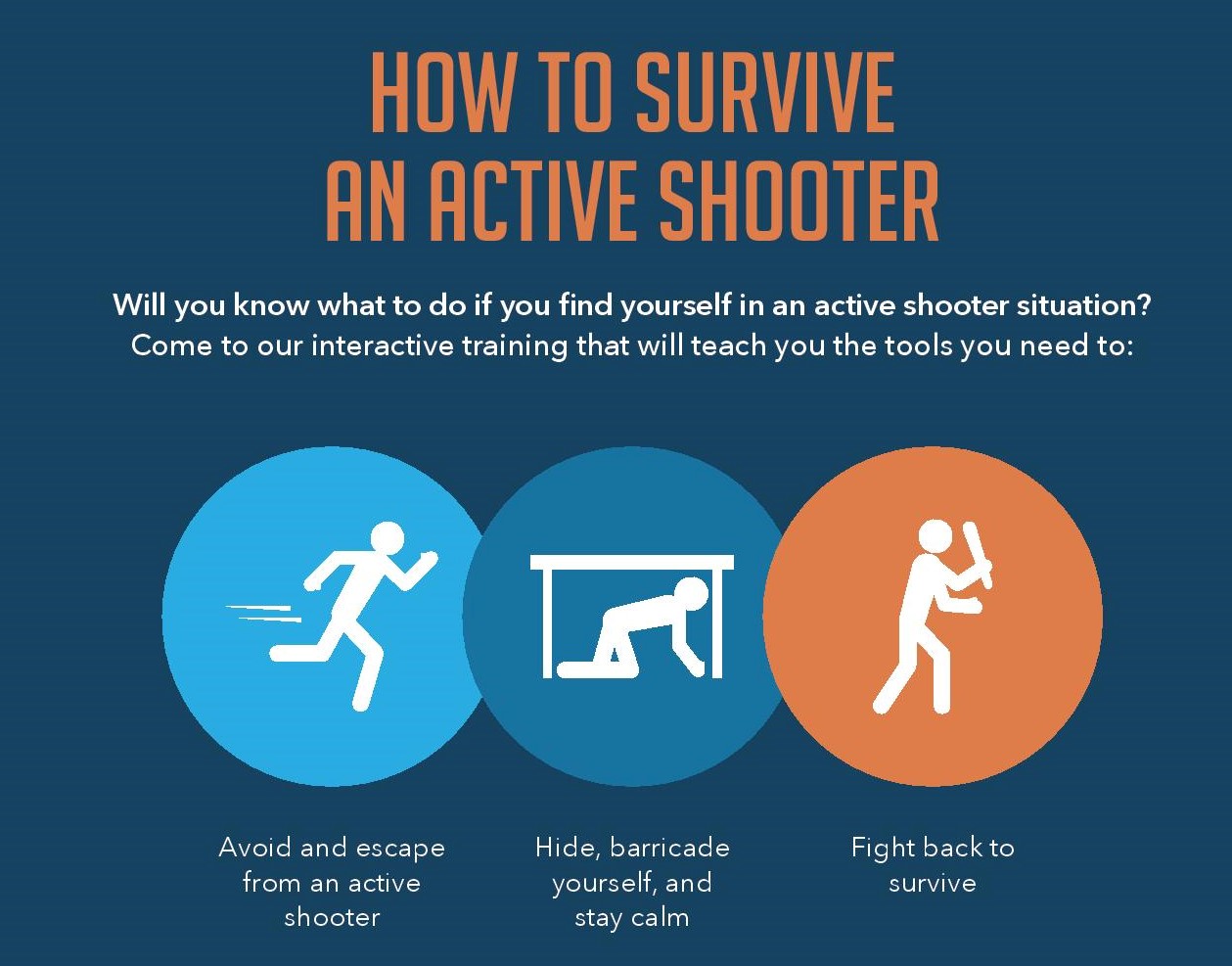How Active Shooter Training Boosts Emergency Feedback Readiness
How Active Shooter Training Boosts Emergency Feedback Readiness
Blog Article
Applying Energetic Shooter Training: Best Practices for Developing a Safe and Prepared Area Setting
As areas face the distressing fact of active shooter occurrences, the execution of detailed training programs becomes necessary. What are the critical components that can transform a typical training program right into a durable version for neighborhood strength?

Recognizing the Need for Educating
In a period marked by increasing occurrences of physical violence in public rooms, comprehending the requirement for active shooter training has actually never been extra important. Detailed training campaigns can gear up individuals with the expertise and skills to react emphatically.
Furthermore, the emotional impact of physical violence on individuals and areas can not be overstated. Training cultivates a feeling of empowerment and preparedness, allowing individuals to feel even more safe in their surroundings. It also promotes a society of safety, where recognition and caution become important parts of everyday life. The benefits of active shooter training expand past immediate action; they consist of boosting communication protocols and enhancing overall precaution within organizations.
Secret Elements of Effective Programs
Effective energetic shooter training programs incorporate numerous key elements that boost readiness and response capabilities. Extensive curriculum advancement is important, making sure that training content is appropriate, evidence-based, and tailored to the particular needs of the company or area. This consists of recognizing the dynamics of energetic shooter cases and the psychological effect on people involved.
Second, realistic training situations should be utilized to simulate possible scenarios, permitting individuals to practice decision-making and action techniques in a regulated setting. These drills assist in muscle mass memory and develop confidence amongst individuals.
Third, an emphasis on communication procedures is critical. Developing clear lines of communication among police, emergency situation -responders, and individuals makes sure collaborated actions throughout a case. Regular updates and refresher programs assist maintain interaction pathways clear and efficient.
4th, ongoing examination and comments systems should be integrated right into the training program - active shooter training. Evaluating the effectiveness of training via individual responses and performance metrics permits for continual renovation
Finally, promoting a society of safety and preparedness within the area motivates watchfulness and positive steps, ensuring that individuals are not just trained but also involved in preserving a secure environment.
Engaging Community Stakeholders

To efficiently engage these stakeholders, it is vital to connect the objectives and benefits of the training. Holding informative sessions can aid clarify the training's objective, address problems, and detail the functions each stakeholder may play. Producing a stakeholder consultatory board can assist in ongoing dialogue, allowing for diverse point of views and understandings to be integrated into the training program.
Structure partnerships with community leaders and companies is likewise important. Their assistance can boost outreach initiatives, boost involvement, and ensure that training is tailored to the one-of-a-kind needs of the community. Furthermore, stakeholders can help in distributing info and resources, enhancing the message of safety and security and readiness.
Eventually, engaging neighborhood stakeholders not only reinforces the training initiative yet also cultivates a feeling of ownership amongst homeowners, bring about an extra resistant and informed area with the ability of responding visit this site successfully to potential risks.
Training Shipment Methods
Using a selection of training distribution methods is vital to accommodate the diverse knowing designs and requirements of individuals in active shooter training programs (active shooter training). Effective training can take numerous types, including talks, hands-on simulations, online modules, and interactive workshops. Each method offers a distinct function and can boost the general discovering experience

Online components provide flexibility and accessibility, making it possible for participants to discover at their very own rate. These can include video clips, quizzes, and conversations to assess understanding. Interactive workshops urge group conversations and analytic, advertising team effort and communication abilities.
Incorporating a mixed method that integrates these techniques not only enhances the training experience however also makes sure that participants are better prepared to react effectively in the occasion of an active shooter circumstance (active shooter training). By addressing different discovering choices, companies can create an extra educated and receptive area
Continual Analysis and Renovation
Routine evaluation and improvement of energetic shooter training programs are critical to preserving their relevance and performance. As dangers this website progress, so must the techniques and methods employed in training. Constant analysis makes sure that training content shows the most up to date knowledge on active shooter occurrences, including lessons gained from recent events and readjusting for emerging patterns.
To facilitate this process, organizations need to develop comments devices that consist of participant examinations, expert evaluations, and case debriefs. Accumulating information on participant efficiency during drills and exercises is vital, as it highlights locations requiring renovation and notifies future training sessions. In addition, engaging with police and emergency responders can offer valuable understandings into the functionality and applicability of training methods.
Frequently arranged reviews of training products and methods should be mandated, promoting a setting of technology and flexibility. our website Organizations has to likewise urge a society of recurring understanding, where employee feel empowered to recommend modifications based on their experiences. By dedicating to continual assessment and improvement, companies not just enhance the efficiency of their energetic shooter training programs but likewise strengthen their general commitment to safety and security and readiness within the neighborhood.
Verdict
To conclude, efficient execution of energetic shooter training requires a thorough method that prioritizes community engagement and realistic simulations. By developing customized educational programs, incorporating varied training techniques, and cultivating cooperation amongst stakeholders, neighborhoods can boost preparedness. Constant evaluation and comments mechanisms are important for adapting programs to emerging hazards, thereby enhancing general safety and security. Inevitably, a commitment to recurring training and renovation grows a culture of caution and readiness, ensuring a more secure environment for all community participants.
Report this page